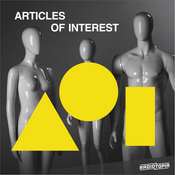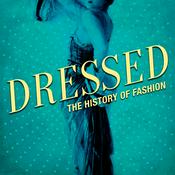670 episodes

David Hunt | Earthboard
2025/12/15 | 53 mins.
My guest this week is David Hunt, the creator of Earthboard. Earthboard is an earth-sized collaborative mural where you claim real-world locations and doodle over famous landmarks across the globe. Draw King Kong climbing the Eiffel Tower, or collaborate with a famous artist in Tokyo, all in real time. Because all art is created inside the app, Earthboard is the first platform where human creativity is architecturally guaranteed. No AI-generated work, period. Every drawing has a limited lifespan, but what you inspire doesn't. Your work lives on in the permanent archive and in the pieces other artists build on top of yours. Earthboard is available now on IOS visit Earthboard.art to learn more Related episodes: Jason deCaires Taylor Marcel Duchamp Check out my other podcasts Fun Facts Daily | Art Smart | Rainbow Puppy Science Lab Who ARTed is an Airwave Media Podcast. If you are interested in advertising on this or any other Airwave Media show, email: [email protected] Learn more about your ad choices. Visit megaphone.fm/adchoices

Pierre de Coubertin & Other Artists Winning Medals at the Olympics (encore)
2025/12/12 | 13 mins.
From 1912 to 1948, medals were awarded for artistic creations inspired by sport, alongside those for athletic prowess. This unique fusion of disciplines was the brainchild of Pierre de Coubertin, the founder of the modern Olympics, who envisioned the Games as a celebration of both physical and intellectual pursuits. Coubertin's vision for the modern Olympics extended far beyond athleticism. He believed in the holistic development of the individual, emphasizing the importance of both physical and intellectual pursuits. This philosophy stemmed from his deep admiration for the ancient Greek ideal of "kalokagathia," which represented the harmonious balance of body and mind. In 1894, Coubertin's efforts culminated in the establishment of the International Olympic Committee (IOC), and the first modern Olympic Games were held in Athens in 1896. The art competitions were introduced at the 1912 Stockholm Games, featuring five categories: architecture, literature, music, painting, and sculpture. A total of 146 artists were awarded Olympic medals for their artistic creations between 1912 and 1948. Tell me which artists/artworks you want me to cover in future episodes at WhoARTedPodcast.com/vote Check out my other podcasts Fun Facts Daily | Art Smart | Rainbow Puppy Science Lab Who ARTed is an Airwave Media Podcast. If you are interested in advertising on this or any other Airwave Media show, email: [email protected] Learn more about your ad choices. Visit megaphone.fm/adchoices

Domenico Ghirlandaio | The Adoration of the Shepherds
2025/12/08 | 12 mins.
Domenico Ghirlandaio stands as a titan of the Quattrocento, often overshadowed by his most famous student, Michelangelo, yet serving as the vital bridge between the early and high Italian Renaissance. As the head of a prolific family workshop, Ghirlandaio dominated the Florentine art market, capturing the spirit of the age by integrating wealthy patrons like the Medici and Tornabuoni directly into sacred biblical narratives. His mastery of fresco technique—skills he later passed to a young Michelangelo—graced the walls of the Sistine Chapel long before the ceiling was painted, establishing him as the premier visual chronicler of 15th-century Florentine society. Beyond his technical precision and workshop efficiency, Ghirlandaio revolutionized Florentine painting by embracing the gritty realism of Northern European art. His masterpiece, The Adoration of the Shepherds in the Sassetti Chapel, merges classical Roman symbolism with unidealized, rugged figures inspired by Flemish masters. This synthesis of high fashion, local architecture, and naturalistic detail offers a vivid window into the life, culture, and theological complexity of Florence at the height of its power. What artist/artworks would you like to learn about? Who should I include in next year's Arts Madness Tournament? Give me your suggestions at www.WhoARTedPodcast.com/vote Check out my other podcasts Fun Facts Daily | Art Smart | Rainbow Puppy Science Lab Who ARTed is an Airwave Media Podcast. If you are interested in advertising on this or any other Airwave Media show, email: [email protected] Learn more about your ad choices. Visit megaphone.fm/adchoices

Max Ernst | Forest and Dove
2025/12/05 | 13 mins.
German artist Max Ernst was a pivotal figure in modern art history, bridging the anarchic rebellion of the Dada movement with the psychological depths of Surrealism. Born in Bruehl and deeply scarred by his service in World War I, Ernst rejected the rigid rationality of his upbringing to explore the unconscious mind. His artistic evolution took him from the avant-garde circles of Cologne and Paris to a dramatic escape from Nazi-occupied Europe with the help of Peggy Guggenheim. Settling in Sedona, Arizona, his presence in the United States proved crucial in bridging the gap between European Surrealism and the emerging American Abstract Expressionist movement. Central to Ernst's legacy are his innovative "automatic" techniques, specifically frottage (rubbing) and grattage (scraping), which allowed chance and texture to dictate composition. A close analysis of his 1927 masterpiece, Forest and Dove, illustrates these methods in action. By scraping paint over textured surfaces to create impenetrable, fossil-like forests, Ernst juxtaposed the menacing power of nature with the fragility of the spirit, often represented by his bird alter ego, "Loplop." His work challenges the role of the artist, suggesting that creators should act as spectators to their own materials to unlock the hidden imagery of the subconscious. Check out my other podcasts Fun Facts Daily | Art Smart | Rainbow Puppy Science Lab Who ARTed is an Airwave Media Podcast. If you are interested in advertising on this or any other Airwave Media show, email: [email protected] Learn more about your ad choices. Visit megaphone.fm/adchoices

Matthew Davis | The Making and Meaning of Mount Rushmore
2025/12/01 | 47 mins.
Mount Rushmore has a complicated and fascinating history. Long before the faces of American presidents were carved into the granite face of the mountain, the land was sacred to the Lakota. Matthew Davis wrote A Biography of a Mountain: The Making and Meaning of Mount Rushmore. He shares his insights into the history from broken treaties to plans for an attraction to boost tourism. Buy the book A Biography of a Mountain: The Making and Meaning of Mount Rushmore on Amazon or your favorite book store. Check out my other podcasts Fun Facts Daily | Art Smart | Rainbow Puppy Science Lab Who ARTed is an Airwave Media Podcast. If you are interested in advertising on this or any other Airwave Media show, email: [email protected] Learn more about your ad choices. Visit megaphone.fm/adchoices
More Arts podcasts
Trending Arts podcasts
About Who Arted: Weekly Art History for All Ages
Listen to Who Arted: Weekly Art History for All Ages, Middagvervolgverhaal and many other podcasts from around the world with the radio.net app

Get the free radio.net app
- Stations and podcasts to bookmark
- Stream via Wi-Fi or Bluetooth
- Supports Carplay & Android Auto
- Many other app features
Get the free radio.net app
- Stations and podcasts to bookmark
- Stream via Wi-Fi or Bluetooth
- Supports Carplay & Android Auto
- Many other app features


Who Arted: Weekly Art History for All Ages
download the app,
start listening.



































